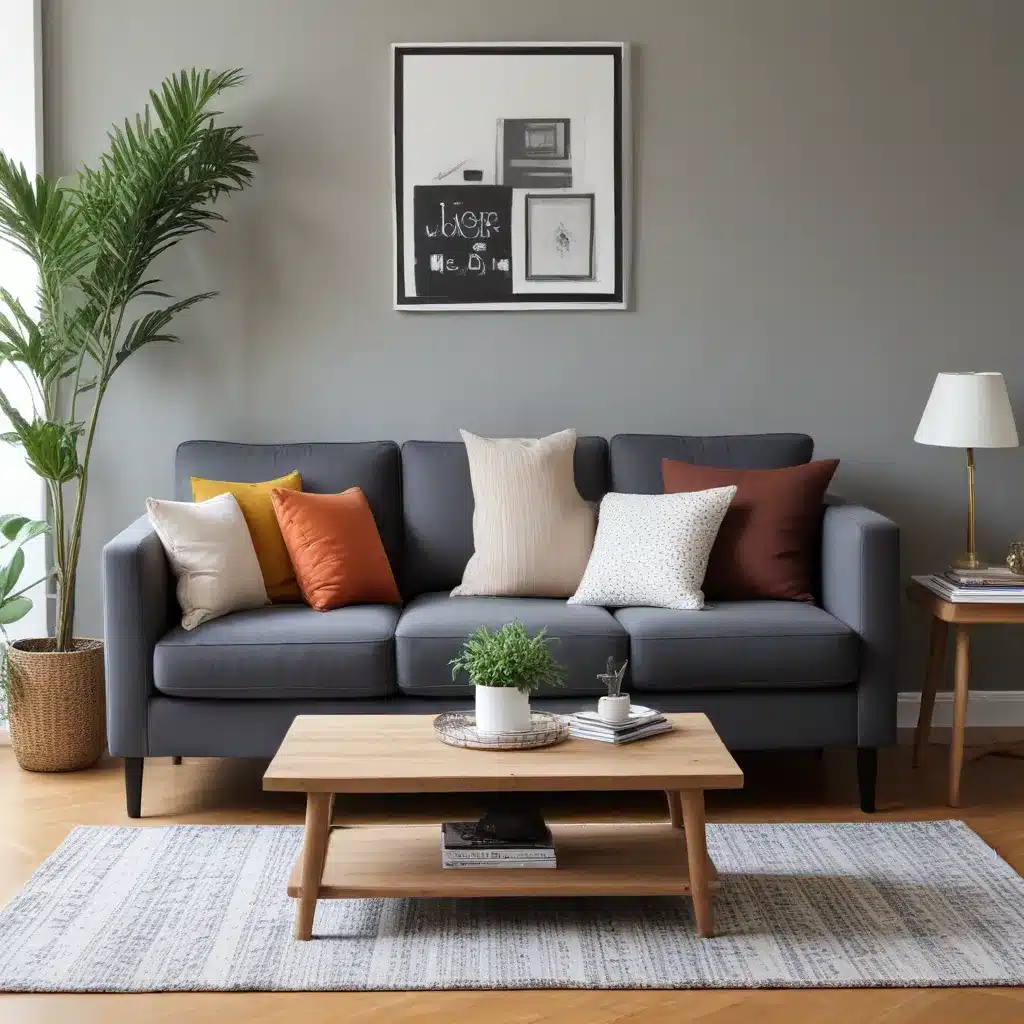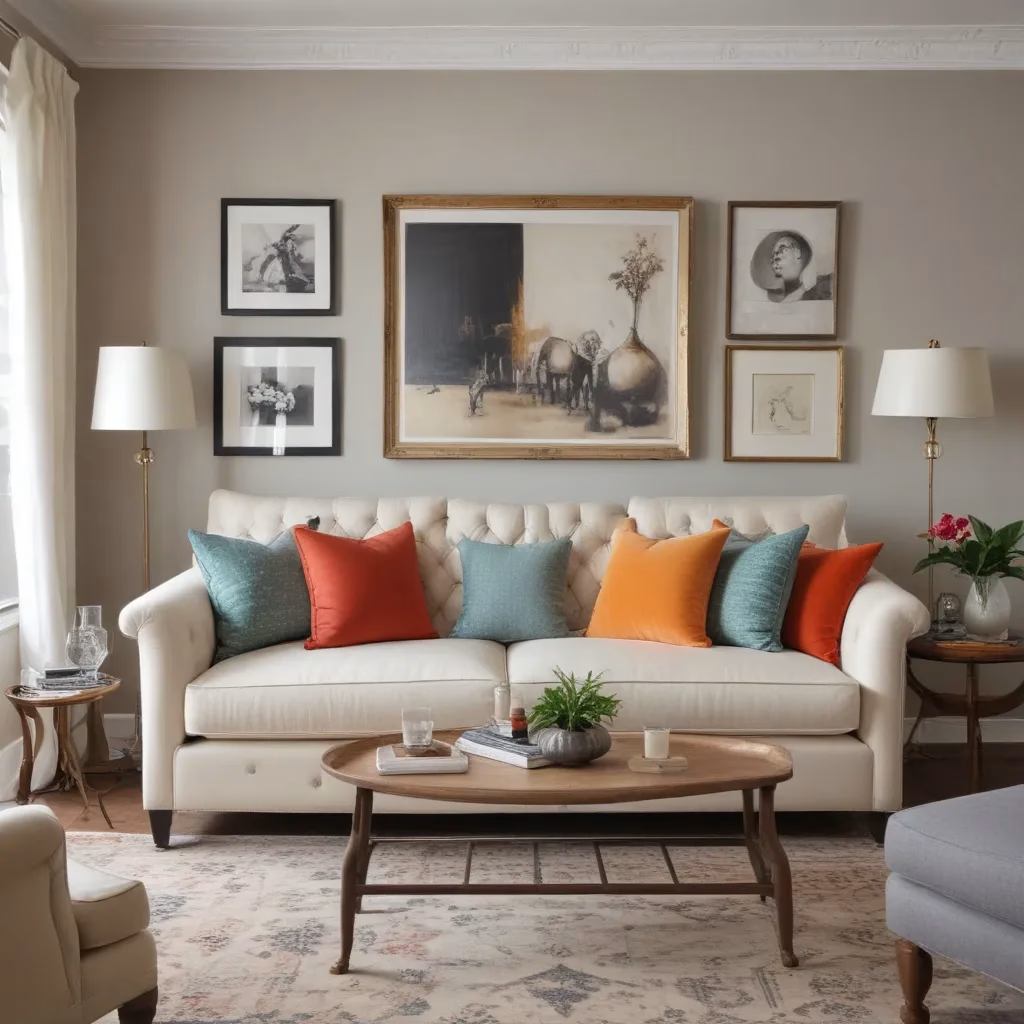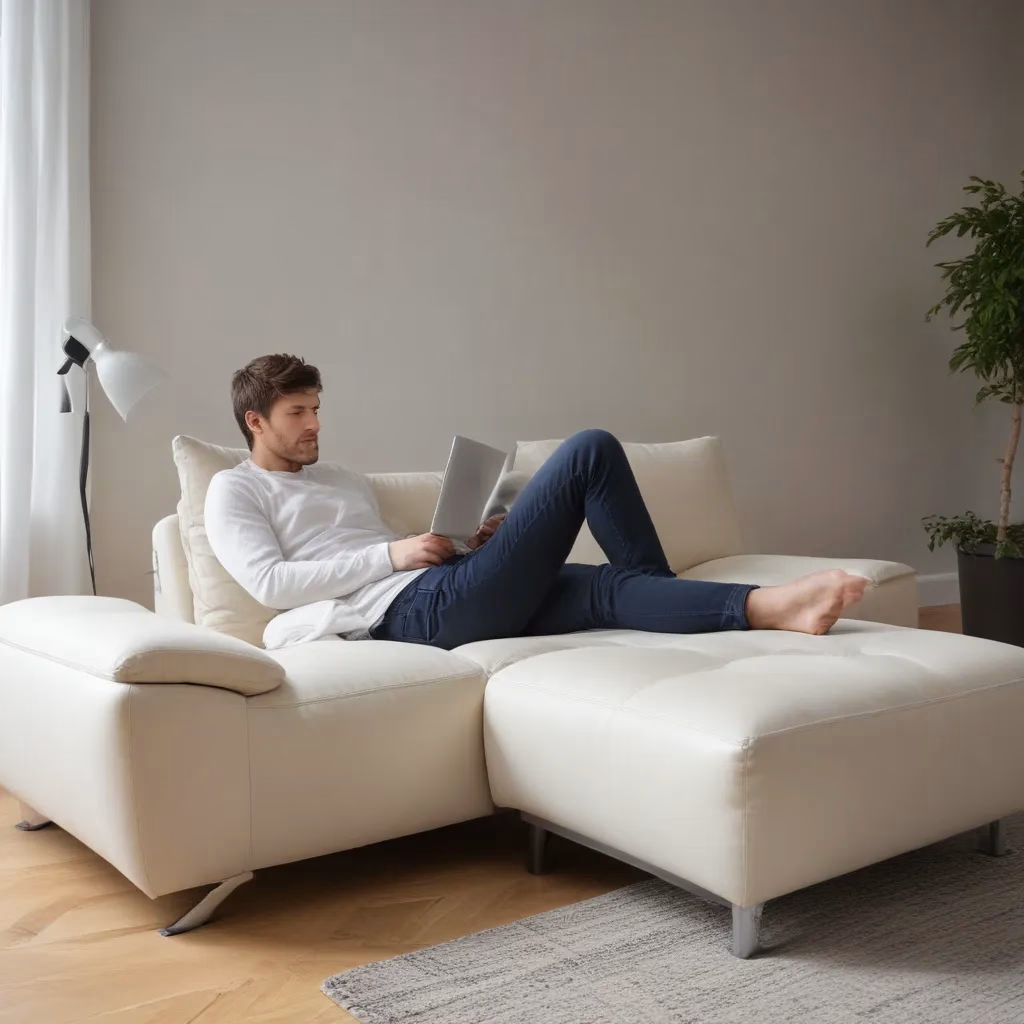
The Power of Furniture Rearrangement
As a furniture specialist, I’ve seen countless living rooms transformed without spending a penny. It’s amazing how a simple rearrangement can breathe new life into a space. One of my favorite techniques is pulling sofas away from the walls. This creates a more intimate seating area and can make your room feel larger.
I once worked with a client who was convinced her living room was too small for entertaining. By simply floating her sofa in the center of the room and adding two armchairs at an angle, we created a cozy conversation area that comfortably seated six. The room suddenly felt spacious and welcoming.
Another budget-friendly tip is to declutter. Remove unnecessary pieces and see how much lighter your room feels. In my own home, I swapped out a bulky three-seater sofa for two streamlined armchairs. The result? A more open, airy space that my family loves spending time in.
Cushion Magic: Small Changes, Big Impact
Never underestimate the power of new cushions! These small accessories can dramatically alter the look and feel of your sofa and, by extension, your entire living room. I always tell my clients that cushions are like jewelry for your furniture – they add that finishing touch that pulls everything together.
When selecting new cushions, consider both color and texture. Bold patterns can inject energy into a neutral sofa, while rich textures like velvet or faux fur add warmth and luxury. I recently updated my own living room by swapping out my old, worn cushions for a mix of jewel-toned velvet and geometric patterned ones. The change was instantaneous and gave my trusty old sofa a whole new lease on life.
Remember, you don’t need to break the bank for quality cushions. I’ve found some fantastic options during my weekly grocery shopping! The key is to look for well-made covers with inserts that hold their shape. And don’t be afraid to mix and match – some of the most interesting sofa looks come from a carefully curated collection of different cushions.
Mirror, Mirror on the Wall
Mirrors are a secret weapon in interior design, especially when you’re working with a smaller space or a limited budget. They reflect light, making rooms appear brighter and more spacious. As someone who’s worked in countless homes, I can attest to the transformative power of a well-placed mirror.
When choosing a mirror for your living room, consider both function and style. A large, rectangular mirror above a sideboard can create the illusion of a wider room. Round mirrors are perfect for softening angular furniture pieces. I once helped a client choose an ornate, Venetian-style mirror to hang above their fireplace – it became an instant focal point and added a touch of glamour to their otherwise minimalist space.
Be mindful of what your mirror will reflect. Ideally, you want it to bounce light from a window or reflect an attractive part of the room. In my own home, I positioned a mirror to reflect my favorite piece of artwork, effectively doubling its impact in the room.
Window Dressing: Curtains and Blinds
Changing your window treatments is another effective way to update your living room without breaking the bank. The right curtains or blinds can dramatically alter the atmosphere of a space, controlling light and adding texture or color.
In my experience, neutral curtains in light colors can make a room feel airier and more spacious. I recently swapped out my own heavy, patterned curtains for simple, off-white ones, and was amazed at how much brighter and more open my living room felt.
Blinds offer another versatile option. Roman blinds add a soft, elegant touch, while Venetian blinds offer excellent light control. I’ve found that online retailers often offer competitive prices on made-to-measure blinds, allowing you to get a custom look without the custom price tag.
When selecting window treatments, consider both aesthetics and practicality. Light, flowing curtains can create a breezy, relaxed atmosphere, but may not provide enough privacy or light control for ground floor rooms. Similarly, while dark curtains can add drama, they may make a small room feel closed in. It’s all about finding the right balance for your space and needs.
The Transformative Power of Paint
If you’re willing to invest a little more time and effort, painting your living room walls can have a dramatic impact. As someone who’s seen countless color transformations, I can’t overstate how much difference a fresh coat of paint can make.
Lighter colors can make a room feel more spacious and airy. I once helped a client transform their small, dark living room by painting the walls a soft, warm white. The change was remarkable – the room felt twice as large and infinitely more welcoming.
On the other hand, don’t be afraid of darker colors. A deep, rich hue on one wall can create a striking focal point. I recently painted one wall in my living room a deep teal, and it’s given the space a whole new level of sophistication.
When choosing paint colors, always test samples on your walls first. The way a color looks in the store or on a screen can be very different from how it appears in your home’s lighting. I always advise clients to live with their sample patches for a few days, observing how the color changes throughout the day.
Bringing Nature Indoors: The Role of Plants
Adding plants to your living room is an easy and affordable way to inject life and color into your space. As a furniture specialist, I’ve seen how the right plant can complement and enhance a room’s design.
Large, leafy plants like fiddle leaf figs or monstera can become striking focal points. I have a tall fiddle leaf fig in the corner of my living room, and its sculptural leaves add a beautiful, organic element to the space.
For those without green thumbs (or with curious pets), high-quality artificial plants can be a great alternative. I’ve found some remarkably realistic faux succulents and small trees that require zero maintenance but still bring that touch of nature indoors.
When incorporating plants, consider both their aesthetic and practical qualities. Some plants, like snake plants or spider plants, are known for their air-purifying properties. Others, like lavender or jasmine, can add a lovely natural fragrance to your room.
Accessorizing: The Final Touch
Once you’ve made larger changes to your living room, it’s time to focus on the details. Accessories are like the seasoning in a good meal – they add flavor and interest to your space.
Start with your coffee table. A carefully curated selection of books, a candle, and a small plant or flower arrangement can create an inviting centerpiece. In my living room, I have a large, rustic wooden tray on my coffee table that corrals these items and makes them feel intentional rather than cluttered.
Wall art is another area where you can make a big impact on a small budget. I’m a big fan of creating gallery walls using a mix of prints, photographs, and small paintings. You can find affordable art prints online, or even frame favorite postcards or pages from old books for a unique, personal touch.
Don’t forget about lighting. Table lamps and floor lamps not only provide practical illumination but also act as decorative elements in their own right. I recently added a sleek, arc floor lamp to my living room, and it’s become a real conversation piece.
Sofa Care: Maintaining Your Investment
While we’ve focused on budget-friendly updates, it’s important to remember that taking care of your existing furniture can save you money in the long run. As someone who’s worked with sofas for years, I can’t stress enough the importance of regular maintenance.
Vacuum your sofa regularly to prevent dust and dirt from settling into the fabric. For leather sofas, wipe them down with a slightly damp cloth every few weeks. If you have a fabric sofa, consider having it professionally cleaned once a year to keep it looking its best.
Protect your sofa from sun damage by using curtains or blinds to filter harsh sunlight. I learned this lesson the hard way when my beautiful blue velvet sofa faded to a patchy mess after a summer of direct sunlight.
Finally, don’t forget to rotate your cushions regularly. This helps them wear evenly and maintain their shape. I make it a habit to flip and rotate my sofa cushions every time I change my bedsheets – it’s an easy way to remember this important task.
The Art of Furniture Placement
Proper furniture placement can make or break a living room, regardless of your budget. Over the years, I’ve developed a few key principles that I always share with my clients.
First, consider traffic flow. You want to create clear pathways through the room without having to navigate around furniture. In my own living room, I’ve positioned the sofa and chairs to create a natural flow from the entrance to the far side of the room.
Next, think about conversation areas. Arrange seating so that people can comfortably talk to each other without having to shout across the room. I like to position chairs at a slight angle to the sofa, creating a more dynamic and inviting seating arrangement.
Don’t push all your furniture against the walls. This is a common mistake I see in many homes. Pulling some pieces away from the wall can create a more intimate, cozy feel. In larger rooms, you can even create multiple seating areas for different activities.
Remember to consider your focal point. This might be a fireplace, a large window with a view, or a TV. Arrange your furniture to highlight this feature. In my living room, I’ve angled the seating slightly towards our beautiful bay window, making the most of the natural light and garden views.
Embracing Texture and Layering
One of the most effective ways to add interest and depth to your living room is through texture and layering. This is an area where you can really get creative without spending a fortune.
Start with your largest pieces – the sofa and any armchairs. If you can’t afford to replace these, consider using slipcovers or throws to add new textures. I recently draped a chunky knit throw over the back of my leather armchair, and it instantly softened the look of the whole room.
Rugs are another great way to add texture and define spaces within a room. In my open-plan living area, I use a large, low-pile rug under the main seating area to create a sense of coziness and separation from the dining space.
Don’t forget about your walls. Textured wallpaper can add interest to a feature wall without the commitment of a bold paint color. I’ve also experimented with fabric wall hangings and even a collection of woven baskets to add visual texture to my walls.
Layering different materials can create a rich, inviting atmosphere. Mix metals, woods, fabrics, and glass for a curated, collected look. In my own home, I have a glass coffee table, wooden side tables, and metal lamp bases, all tied together with fabric upholstery and soft furnishings.
The Impact of Lighting
Lighting is often overlooked when it comes to budget room updates, but it can have a huge impact on the look and feel of your living room. As a furniture specialist, I always encourage my clients to think carefully about their lighting choices.
Start by maximizing your natural light. Clean your windows and ensure your window treatments allow plenty of light in during the day. If privacy is a concern, consider sheer curtains or bottom-up blinds that let in light while maintaining privacy.
When it comes to artificial lighting, aim for a mix of ambient, task, and accent lighting. Overhead lights provide general illumination, but they can be harsh on their own. I always recommend using a dimmer switch for overhead lights to allow for greater control.
Table and floor lamps are essential for creating a warm, inviting atmosphere. I have several lamps at different heights around my living room, which allows me to create different moods depending on which ones I turn on.
Don’t forget about accent lighting. Use spotlights or picture lights to highlight artwork or architectural features. In my home, I have a small, battery-operated picture light above a favorite painting – it draws the eye and creates a lovely, intimate glow in the evenings.
Conclusion: Your Living Room, Your Style
Updating your living room doesn’t have to be an expensive endeavor. With a little creativity and some strategic changes, you can transform your space on a budget. Remember, the key is to focus on the elements that will have the biggest impact – whether that’s rearranging your furniture, adding new accessories, or simply decluttering.
As you make these changes, always keep your personal style and needs in mind. Your living room should be a reflection of you and a space where you feel completely at home. Don’t be afraid to experiment and have fun with the process.
If you’re looking for more inspiration or specific advice for your space, I highly recommend checking out Sofa Spectacular. They have a wealth of information on sofa styles, care tips, and living room design ideas.
Remember, creating a beautiful living room is a journey, not a destination. Enjoy the process of refining and updating your space over time. Happy decorating!



